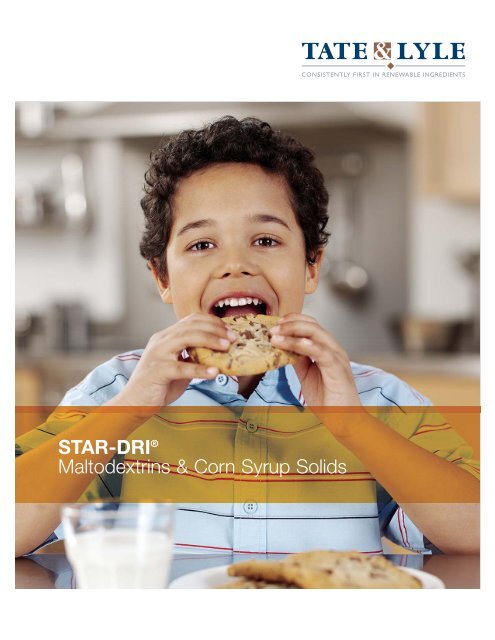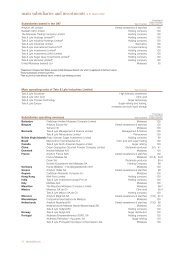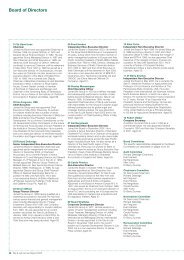STAR-DRI® Maltodextrins & Corn Syrup Solids - Tate & Lyle
STAR-DRI® Maltodextrins & Corn Syrup Solids - Tate & Lyle
STAR-DRI® Maltodextrins & Corn Syrup Solids - Tate & Lyle
You also want an ePaper? Increase the reach of your titles
YUMPU automatically turns print PDFs into web optimized ePapers that Google loves.
<strong>STAR</strong>-DRI ®<br />
<strong>Maltodextrins</strong> & <strong>Corn</strong> <strong>Syrup</strong> <strong>Solids</strong>
1<br />
Consistently first in renewable ingredients<br />
<strong>Tate</strong> & <strong>Lyle</strong> is a world leading manufacturer of renewable food and industrial<br />
ingredients. We use innovative technology to transform corn, wheat and sugar<br />
into value-added ingredients for customers in the food, beverage, pharmaceutical,<br />
cosmetic, paper, packaging and building industries.<br />
The Company is a leader in cereal sweeteners and starches,<br />
sugar refining, value-added food and industrial ingredients, and<br />
citric acid. <strong>Tate</strong> & <strong>Lyle</strong> is the world number-one in industrial<br />
starches and is the sole manufacturer of SPLENDA ® Sucralose.<br />
Our investment in R&D and our technical expertise is focused on<br />
meeting your needs, helping you deliver increased functionality<br />
and choice to consumers. From design through development to<br />
manufacturing, <strong>Tate</strong> & <strong>Lyle</strong> has the ingredients and solutions to<br />
help you create products with the right profiles for your markets.<br />
SPLENDA ® is a trademark of McNeil Nutritionals, LLC
<strong>STAR</strong>-DRI ® maltodextrins<br />
As people strive for healthier diets, food processors are challenged to maintain high<br />
quality while changing formulations to meet new consumer demands. <strong>STAR</strong>-DRI ®<br />
maltodextrins from <strong>Tate</strong> & <strong>Lyle</strong> are ingredients that make significant contributions to<br />
successful new food products containing less fat, fewer calories and increased<br />
complex carbohydrate levels.<br />
<strong>STAR</strong>-DRI ® maltodextrins have commonly been used in a wide<br />
variety of foods for their contributions to texture, viscosity,<br />
moisture control, film formation and other functionalities.<br />
Today, <strong>STAR</strong>-DRI ® products are being used in new ways to<br />
economically control various quality features in reduced-fat<br />
foods – foods generally higher in moisture than their<br />
full-fat counterparts.<br />
<strong>STAR</strong>-DRI ® maltodextrins contain complex carbohydrates<br />
and provide a means of carbohydrate loading in<br />
specialized applications.<br />
In both traditional and contemporary foods, <strong>STAR</strong>-DRI ®<br />
maltodextrins provide important functionalities that add to<br />
food quality.<br />
What are <strong>STAR</strong>-DRI ® maltodextrins?<br />
<strong>STAR</strong>-DRI ® maltodextrins are a series of products produced<br />
from corn starches. They are available in dent or waxy corn<br />
varieties. <strong>STAR</strong>-DRI ® 100, 150 and 180 are dent-based<br />
products and <strong>STAR</strong>-DRI ® 1, 5, 10, 15, 18, 1005A and 1015A<br />
are waxy maltodextrins.<br />
<strong>STAR</strong>-DRI ® maltodextrins are classified by Dextrose Equivalent<br />
or DE, which is a measure of the reducing sugars present<br />
calculated as dextrose and expressed as a percentage of the<br />
total dry substance. Glucose or dextrose has a DE of 100.<br />
<strong>STAR</strong>-DRI ® maltodextrins have DE values of less than 20.<br />
Table 1 (page 3) lists <strong>STAR</strong>-DRI ® maltodextrins in ascending<br />
order based on DE and briefly identifies each product and<br />
its applications.<br />
Although DE values are useful for identification and manufacturing<br />
control, the properties of <strong>STAR</strong>-DRI ® products are largely due to<br />
their carbohydrate or saccharide profiles. Saccharide distribution<br />
profiles for a series of <strong>STAR</strong>-DRI ® maltodextrins are given in<br />
Table 2 (page 3).<br />
2
3<br />
Table 1: Description of <strong>STAR</strong>-DRI ® maltodextrins<br />
<strong>Maltodextrins</strong> DE Density (lb./cu.ft.) Form Applications<br />
<strong>STAR</strong>-DRI ® 1 1 31 Standard powder Bakery mixes, flavor carrier, binder<br />
<strong>STAR</strong>-DRI ® 5 5 32 Standard powder Flavor carrier, frostings, dairy desserts<br />
<strong>STAR</strong>-DRI ® 10<br />
<strong>STAR</strong>-DRI ® 100<br />
10 34 Standard powder Flavor carrier, dairy desserts, sugar fondants, batters<br />
<strong>STAR</strong>-DRI ® 1005A 10 5 Agglomerate Nutritional beverages, dry mixes, dispersant, bulking agent<br />
<strong>STAR</strong>-DRI ® 1015A 10 17 Agglomerate Nutritional beverages, dry mixes, dispersant, bulking agent<br />
<strong>STAR</strong>-DRI ® 15<br />
<strong>STAR</strong>-DRI ® 150<br />
<strong>STAR</strong>-DRI ® 18<br />
<strong>STAR</strong>-DRI ® 180<br />
15 35 Standard powder Confections, beverage mixes, dairy desserts<br />
18 36 Standard powder Flavor carrier, dairy desserts<br />
LIQUID 3260 18 N/A Liquid 70% D.S. Spray drying carrier<br />
Table 2: Typical saccharide analysis of <strong>STAR</strong>-DRI ® maltodextrins<br />
Analysis<br />
<strong>STAR</strong>-DRI ® products<br />
1 5 100 150 180<br />
Dextrose equivalent (DE) 1.0 5.0 10.0 15.0 18.0<br />
Saccharide distribution (%)<br />
Monosaccharide, DP1 0.3 0.9 0.6 1.3 1.5<br />
Disaccharide, DP2 0.1 0.9 2.8 4.1 6.0<br />
Trisaccharide, DP3 0.2 1.0 4.4 6.0 8.3<br />
Tetrasaccharide, DP4 1.1 3.5 4.6 5.8<br />
Pentasaccharide, DP5 1.3 3.8 5.2 6.9<br />
Hexasaccharide, DP6 1.4 5.7 7.6 10.2<br />
Heptasaccharide, DP7 1.5 5.4 6.3 7.0<br />
Octasaccharide, DP8 1.4 4.0 4.4 4.1<br />
Nonasaccharide, DP9 1.4 3.2 3.5 3.1<br />
Decasaccharide, DP10 1.3 2.7 3.0 2.5<br />
Higher saccharide, DP11+ 99.4 87.8 64.0 54.0 44.6
5<br />
Applications for <strong>STAR</strong>-DRI ® products<br />
<strong>STAR</strong>-DRI ® maltodextrins are used in a wide variety of reduced<br />
and full-calorie foods – dry mixes of all kinds, confections,<br />
frostings, desserts, salad dressings, spreads, and sports drinks<br />
for example. Applications for specific <strong>STAR</strong>-DRI ® products are<br />
included in Table 1 (page 3). <strong>Tate</strong> & <strong>Lyle</strong>’s applications research<br />
staff continue to explore new uses for <strong>STAR</strong>-DRI ® products in<br />
foods that appeal to today’s consumers.<br />
Functional properties<br />
Effect of DE on functional properties – <strong>STAR</strong>-DRI ® products<br />
have a number of features that make them valuable as<br />
dispersing aids, flavor carriers, bulking agents, humectants,<br />
viscosity stabilizers, and other functional ingredients. Features of<br />
<strong>STAR</strong>-DRI ® maltodextrins are listed in Table 3 according to their<br />
DE values. Figure 1 graphically represents the changing impact<br />
of DE values on key functional properties. Many of the<br />
functionalities in Table 3 and Figure 1 are dependent on the<br />
ability of <strong>STAR</strong>-DRI ® products to control water in food systems.<br />
Viscosity – <strong>STAR</strong>-DRI ® products help maintain viscosity and<br />
body in various foods, and for this reason, they are ideal in<br />
reduced-fat products. Applications include salad dressings,<br />
dairy spreads, and dairy desserts.<br />
Knowledge of the impact of particular <strong>STAR</strong>-DRI ® maltodextrins<br />
on viscosity is important in formulating and handling food<br />
systems. The effect of specific <strong>STAR</strong>-DRI ® products on apparent<br />
solution viscosities at 100°F is shown in Figure 2. <strong>STAR</strong>-DRI ®<br />
maltodextrins are considered economical “soluble” forms of<br />
viscosity or body.<br />
Osmolality – <strong>STAR</strong>-DRI ® maltodextrins are also used for their<br />
impact on the osmolality of beverages being used increasingly<br />
by athletic individuals.<br />
Figure 1: Effect of dextrose equivalent on properties<br />
of maltodextrins<br />
Property Dextrose equivalent<br />
Film formation<br />
Viscosity<br />
Hygroscopicity<br />
Browning<br />
Light transmission<br />
Sweetness<br />
Humectancy<br />
Plasticity<br />
Table 3: Features of maltodextrins<br />
Feature<br />
Solubility<br />
Nutritive value<br />
Resistance to caking<br />
Adhesion/binder<br />
Mouthfeel/body<br />
Blandness<br />
Encapsulation<br />
0 18<br />
Dextrose equivalent<br />
1 5 10 15
Isotonic solutions exhibit no osmotic difference across<br />
membranes. This occurs at about 350 milliosmoles. More<br />
nutrient dense beverages can be produced with maltodextrins<br />
without adversely affecting osmolality. The effect of the<br />
concentration on theoretical osmolality in a series of<br />
<strong>STAR</strong>-DRI ® products is shown in Figure 3.<br />
High performance sports drinks can be formulated with<br />
<strong>STAR</strong>-DRI ® maltodextrins and KRY<strong>STAR</strong> ® crystalline fructose<br />
to increase carbohydrate content with a limited increase in<br />
osmolality. The use of <strong>STAR</strong>-DRI ® 100 maltodextrin provides<br />
four times the number of calories, with only a 20% increase in<br />
osmolality compared to a commercial sports drink made<br />
with a simple sugar. See Table 4.<br />
Table 4: Comparison of two sports drinks<br />
Test or analysis<br />
Commercial<br />
sport drink<br />
<strong>Tate</strong> & <strong>Lyle</strong><br />
formula<br />
mOsm/1000g H2O 340 416<br />
Cal/1000g H2O 255 1030<br />
Figure 2: <strong>STAR</strong>-DRI ® solution viscosities – temperature<br />
at 100ºF<br />
Viscosity in centipoise<br />
Osmolality (mOsm/kg water)<br />
% <strong>Solids</strong><br />
<strong>STAR</strong>-DRI ® 1 <strong>STAR</strong>-DRI ® 5 <strong>STAR</strong>-DRI ® 100 <strong>STAR</strong>-DRI ® 150<br />
Figure 3: Theoretical osmolality of maltodextrin solution<br />
% <strong>Solids</strong><br />
<strong>STAR</strong>-DRI ®<br />
1 DE 5 DE 10 DE 15 DE 18 DE<br />
6
7<br />
Forms of <strong>STAR</strong>-DRI ® products<br />
<strong>STAR</strong>-DRI ® maltodextrins are available in a number of different<br />
forms that facilitate their use in different applications. <strong>STAR</strong>-DRI ®<br />
products are produced primarily in powder form (standard and<br />
agglomerated) although liquid forms are also made. Bulk density<br />
generally correlates to and is used to describe the form of dry<br />
powdered products. Several different outcomes are a result of<br />
product form and density. Bulk densities and the form of<br />
<strong>STAR</strong>-DRI ® products are included in Table 1 (page 3). Visual<br />
differences between the products can be seen in Figure 4.<br />
<strong>STAR</strong>-DRI ® powders – <strong>STAR</strong>-DRI ® standard powders are<br />
suitable for most applications. They have loose bulk densities of<br />
30-40 pounds per cubic foot (0.48-0.64g/cc). Standard<br />
powders are generally produced via traditional spray-drying and<br />
are the most common form of maltodextrins.<br />
<strong>STAR</strong>-DRI ® agglomerated products – <strong>STAR</strong>-DRI ® 1005A and<br />
1015A are agglomerated products with bulk densities controlled<br />
between 5 and 18 pounds per cubic foot (0.08-0.28g/cc). The<br />
low bulk densities make the products well-suited as bulking<br />
agents for use in food microcomponents such as non-nutritive<br />
sweeteners. Agglomerated products have good flowability,<br />
excellent particle strength, and aid in the dispersion of hard to<br />
disperse ingredients (instant starches, for example). Their low<br />
tendency to dust makes them highly useful in processes<br />
involving demanding physical conditions.<br />
<strong>STAR</strong>-DRI ® maltodextrin liquids – Liquid forms of <strong>STAR</strong>-DRI ®<br />
products are especially good for high volume applications<br />
involving resolubilization or use as a drying carrier.<br />
Figure 4: Microphotographs of <strong>STAR</strong>-DRI ® products<br />
<strong>STAR</strong>-DRI ® 5 (136X magnification)<br />
<strong>STAR</strong>-DRI ® 1015A (140X magnification)
9<br />
<strong>STAR</strong>-DRI ® corn syrup solids for traditional and<br />
contemporary foods<br />
<strong>STAR</strong>-DRI ® corn syrup solids meet the highest of applicable quality standards found in<br />
the food industry today. They are traditional ingredients which have been responsible<br />
for the success of a wide variety of food and ingredient applications.<br />
<strong>STAR</strong>-DRI ® corn syrup solids, with their relatively lower levels of simple sugars, add to<br />
complex carbohydrates. <strong>Corn</strong> syrup solids are useful ingredients in the reduction of<br />
fats by replacing them with carbohydrates.<br />
Table 5: Description of <strong>STAR</strong>-DRI ® corn syrup solids<br />
<strong>Corn</strong> syrup solids DE<br />
<strong>STAR</strong>-DRI ® 20<br />
<strong>STAR</strong>-DRI ® 200<br />
Density<br />
(lb./cu.ft.)<br />
Form Applications<br />
20 38 Standard powder Adult and infant nutritional formulas, salad dressings<br />
<strong>STAR</strong>-DRI ® 240 24 38 Standard powder Adult and infant nutritional formulas, salad dressing<br />
<strong>STAR</strong>-DRI ® 42R 44 38 Regular ground Meats, dry mixes, ice cream, frostings, fondants, confections<br />
<strong>STAR</strong>-DRI ® 42C 44 35 Coarsely ground Meats, dry mixes, ice cream
Typical properties<br />
The typical properties of <strong>STAR</strong>-DRI ® corn syrup solids and<br />
applications for these ingredients are listed in Table 5.<br />
Dextrose equivalent – <strong>Corn</strong> syrup solids are classified as<br />
having a Dextrose Equivalent (DE) of 20 or greater. DE is a<br />
measure of the reducing sugars present calculated as dextrose<br />
and expressed as a percentage of the total dry substance.<br />
Glucose or dextrose has a DE of 100.<br />
The DE’s of <strong>STAR</strong>-DRI ® corn syrup solids are listed in Table 6.<br />
Density/form<br />
<strong>STAR</strong>-DRI ® 200 and 240 standard powders have a loose<br />
bulk density of between 30 and 40 pounds per cubic foot<br />
(0.48-0.64g/cc). They are produced via spray-drying.<br />
<strong>STAR</strong>-DRI ® 42 R and C are produced by grinding corn syrup<br />
solids into regular and coarse particle sizes. These products<br />
have loose bulk densities ranging from 35 to 38 pounds per<br />
cubic foot (0.56-0.61g/cc).<br />
Solution properties of <strong>STAR</strong>-DRI ® corn syrup solids<br />
Knowledge of how particular <strong>STAR</strong>-DRI ® corn syrup solid<br />
products impact the viscosity of a given food system or simple<br />
solution is important from formulation and handling standpoints.<br />
Figure 5 displays the impact of various concentrations of<br />
<strong>STAR</strong>-DRI ® products on apparent solution viscosities at 100°F.<br />
Use of <strong>STAR</strong>-DRI ® products is ideal for maintaining viscosity and<br />
body as fat content is reduced in products such as salad<br />
dressings, dairy spreads and dairy desserts.<br />
Labeling<br />
<strong>STAR</strong>-DRI ® 1, 5, 10, 100, 1005A, 1015A, 15, 150, 18, 180 and<br />
liquid 3260 products are labeled “maltodextrin” on ingredient<br />
statement panels.<br />
<strong>STAR</strong>-DRI ® 20, 200, 240 and 42 products are labeled “corn<br />
syrup solids” on ingredient statement panels.<br />
For information on specific declarations, contact your legal<br />
counsel or appropriate regulatory agency.<br />
Table 6: Typical saccharide analysis of <strong>STAR</strong>-DRI ® corn<br />
syrup solids<br />
Analysis<br />
Figure 5: <strong>STAR</strong>-DRI ® solution viscosities – temperature<br />
at 100ºF<br />
Viscosity in centipoise<br />
% <strong>Solids</strong><br />
<strong>STAR</strong>-DRI ® 200 <strong>STAR</strong>-DRI ® 42R<br />
<strong>STAR</strong>-DRI ® products<br />
200 240 42<br />
Dextrose equivalent (DE) 21.5 24.3 43.5<br />
Saccharide distribution (%)<br />
Monosaccharide, DP1 2.1 5.5 19.6<br />
Disaccharide, DP2 8.1 9.3 15.1<br />
Trisaccharide, DP3 10.0 11.1 11.8<br />
Tetrasaccharide, DP4 6.8 7.5 9.2<br />
Pentasaccharide, DP5 8.4 9.2 7.4<br />
Hexasaccharide, DP6 11.4 12.0 5.9<br />
Heptasaccharide, DP7 6.6 6.4 4.8<br />
Octasaccharide, DP8 4.0 3.3 3.9<br />
Nonasaccharide, DP9 3.1 3.3 3.2<br />
Decasaccharide, DP10 2.5 2.3 2.6<br />
Higher saccharide, DP11+ 37.1 30.1 16.5<br />
Molecular weight average, (MW) 3746.0 3116.0 1120.0<br />
Molecular number average, (MN) 874.0 583.0 490.0<br />
Polydispersity (MW/MN) 4.3 5.3 2.3<br />
10
For more information please contact:<br />
<strong>Tate</strong> & <strong>Lyle</strong><br />
2200 East Eldorado Street<br />
Decatur, Illinois 62525<br />
(Parcel service deliveries: 62521)<br />
USA<br />
Tel: 800 526 5728 or (+1) 217 423 4411<br />
Fax: (+1) 217 421 3167<br />
www.tateandlyle.com<br />
All information in this brochure has been carefully compiled but no<br />
guarantee can be given of its applicability in any given situation<br />
because of the wide variation in conditions of use. Nothing in this<br />
information should be construed as a recommendation to use our<br />
products, including SPLENDA ® Sucralose, in violation of any patent or<br />
as a warranty (express or implied) of non-infringement of any patent<br />
rights. Prospective purchasers are invited to conduct their own tests<br />
and studies to determine the fitness of <strong>Tate</strong> & <strong>Lyle</strong>’s products for their<br />
particular purposes and specific applications. The approval status of<br />
SPLENDA ® Sucralose should always be confirmed with the<br />
appropriate governmental agencies for its intended use.<br />
© <strong>Tate</strong> & <strong>Lyle</strong> 2005<br />
STD0106US047







